
|   |

|   |
Enthralling performances at SNA's International Festival of Indian Dance - Vijay Shanker e-mail: vijaydance@gmail.com Photos courtesy: SNA November 9, 2024 Sangeet Natak Akademi, Ministry of Culture, Government of India, with the support from Indian Council of Cultural Relations (ICCR) and Lalit Kala Akademi, organised the six days International dance conference at the AP Shinde Symposium, National Agricultural Science Complex in Inder Puri, New Delhi and performances at the Kamani auditorium in the evening. It was exhilarating to witness this unique congregation of classical dancers, singers, musicians, folk dancers, dance mentors, scholars and critics arriving from varied parts of this globe to participate and celebrate the life of dance with a contemporary perspective. The festival commenced on 16th October and concluded on 21st October with a grand folk dance extravaganza from over 28 states and union territories. 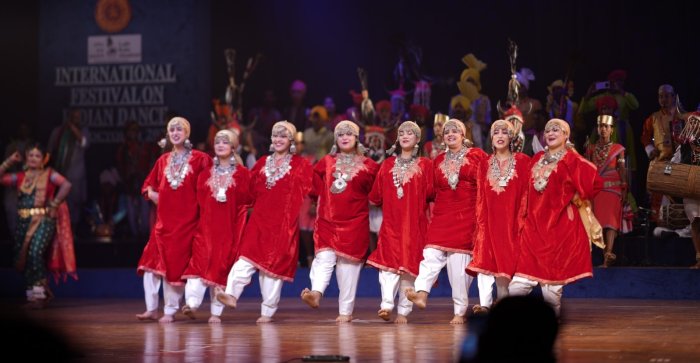 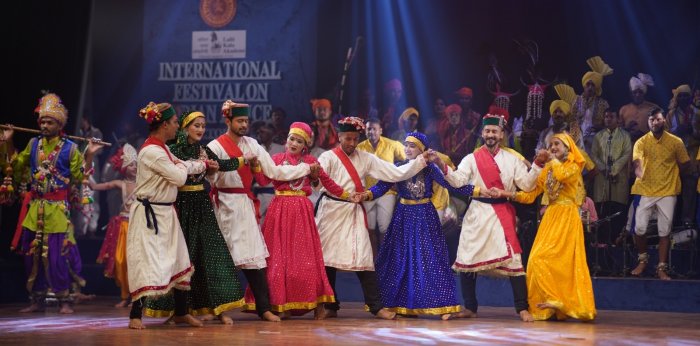 The first performer of the festival was Dr Sonal Mansingh who effortlessly narrated the story of the saint poetess Meerabai along with the singing of verses of Meera bhajans like "Mere toh Giridhar Gopal, doosra na koi", "Pag ghungroo Meera nachi re" and other renditions that defined Meera's complete devotion for Krishna. As a young girl, she was gifted an idol of Lord Krishna and was told by her mother that Krishna is her partner. The young Meera was completely in love with the idol without realising that he was not any ordinary human being but Lord Krishna himself. After becoming a young maiden, Meera got married to Raja Jai Singh of Mewar. After marriage Meera told her husband that she was already married to Lord Krishna, and the King laughed it off, without realising the implications. Meera's devotion increased to the extent that she would dance and sing in his praise and people felt that she was "bawri" (mad) and they decided to boycott her from the community. Meera was offered poison that turned to nectar and the serpent that was offered to her became her garland, such was her ardent devotion for the Lord. Meera sacrificed her royal life to be united with her Lord. Ultimately Meera merged with her Lord in Dwaraka and received enlightenment and moksha. Sonal Mansingh's immaculate and powerful rendering took the audience to a higher level of consciousness. She was supported by a team of dancers and musicians that left an indelible impression on the audience. 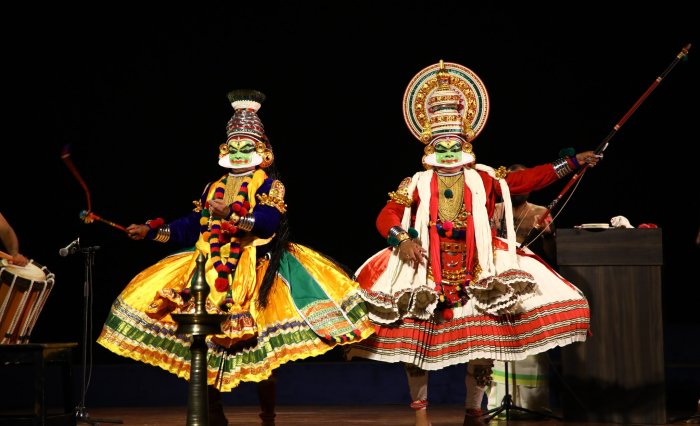 Kerala Kalamandalam Eminent Kathakali actors Kalamandalam Balasubramanyam, Harinarayan and members of Kerala Kalamandalam performed 'Geetopadesam' in the Kathakali style. Pertaining to Srimad Bhagwat, the Geetopadesam is one of the most significant chapters that portrays the thought provoking dialogues between Krishna and Arjuna in the battlefield of Kurukshetra, that justifies the promotion of dharma (righteousness) over adharma in order to restore and protect peace, happiness and prosperity in the society. "Yada yada hi dharmasya, glanir bhavati bharata, abhyukatanama dharmasya tadatman srujamyaham" (Whenever and wherever there is a decline in religious practise, O decadent of Bharata, and a predominant rise of irreligion - at that time I descend myself), Bhagavad Gita chapter 47. Arjuna's initial hesitation on seeing his relatives and his family members on the battlefield, Lord Krishna's logical reasoning and ultimate appearance of Vishwaroopa darshanam, makes Arjuna realise the significance of both Dharma and Karma. The powerful mukhaja abhinaya particularly the netra abhinaya, the overpowering of hesitation that changes and transforms the psyche and the mental conditioning of Arjuna in the realisation of his duties and final tussle against the Kauravas, formed the mainstay of the presentation that was applauded by the audience. 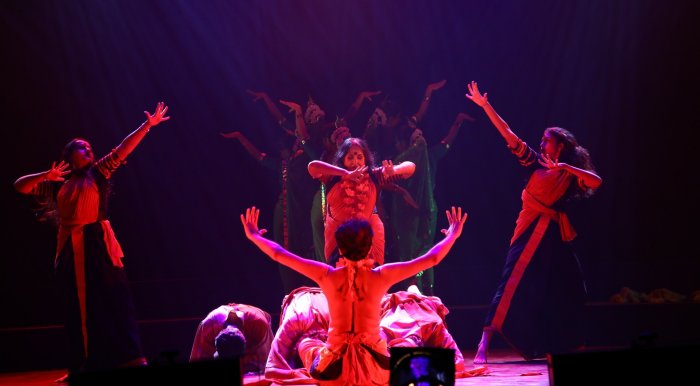 Mamata Shankar group Mamata Shankar Dance Company (Kolkata) presented Prakruti with a fine team of dancers, led by Mamata Shankar. Enthralling music, uniformity, elegance of swaying and flowing movements created a fine spectacle as twelve dancers, five males and seven females, moved aesthetically with synchronised movements that reminded one of the pioneer of traditional Indian ballet, master choreographer Uday Shankar. The model of the forest and earthen mount and their interaction, the subsequent rain and thunderstorm, highlighted the significance of nature in all its splendour and how important it is for man to maintain and preserve nature in its pristine form and glory. Witnessing the performance was so refreshing that established the statement that the elegance and aesthetic quality of any performance is of prime importance. 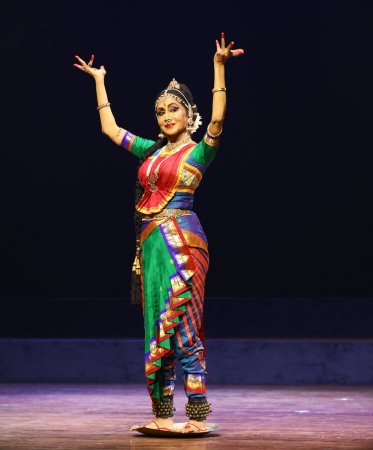 Shanta Ratii Kuchipudi exponent Shantha Ratii from Singapore rendered a flawless brief performance. In her rendering of Balagopala Tarangam, while extolling the glory of Lord Krishna, Shantha demonstrated rhythmic movements on the rim of the brass plate. The rhythmic patterns are played on the mridangam and subsequently the dancer executes the same rhythm, revealing her mastery over footwork and rhythm. 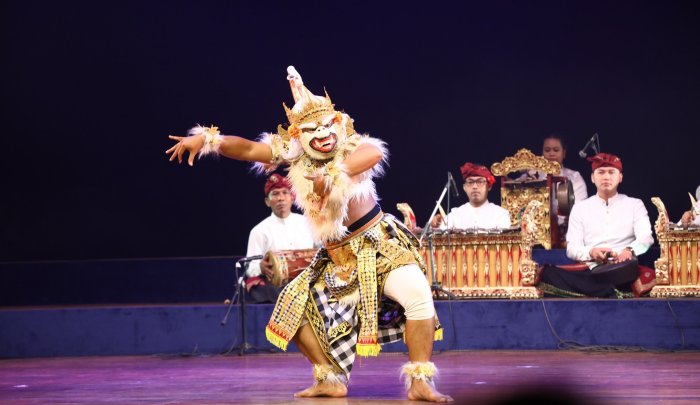 Taksu Art One of the most unusual and unique presentations of the festival, was the concise version of Ramayana by the troupe from Indonesia. The Taksu Art group was attired in colourful and grand costumes, the monkey faced Hanuman, the beautiful head gear of Rama and Lakshmana and the villain look of Ravana. Unlike the traditional Indian Ramayana rendering in which the songs, the sahitya reveal the story, here it was the instrumental music that would change according to the temperament or the intensity of the scenes. The scene opens with tussle between Jatayu and Ravana. Later the scene is diverted to Sita in exile and how Ravana tries to dupe her, the appearance of Hanuman, the tussle between Rama and Ravana and ultimately the union of Rama and Sita. The movements were limited and restrictive and the expressions changed to minimalist level but what caught the attention of the spectators was the beautiful and grand costumes; in fact it was more of a costume drama. 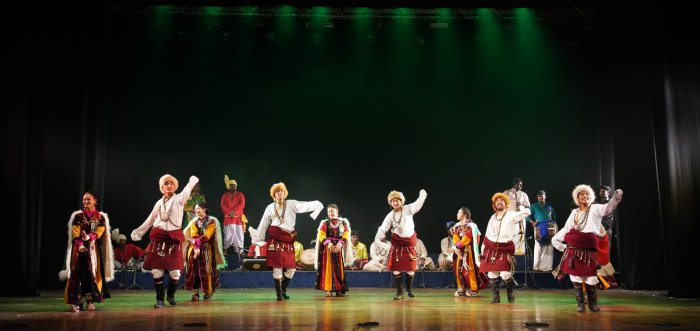 Zhyuldyz Dance Ensemble Zhyuldyz Dance Ensemble from Kyrgyzstan presented a brief and joyous dance that was noteworthy for its jumping and light movements, enthralling the audience with their enthusiasm and spirit. Sunanda Nair, disciple of Dr Kanak Rele, presented a brief and elevating Mohiniattam performance pertaining to the ultimate encounter of devotee Sabari with Lord Rama. After several years of anticipation, Sabari is overjoyed to have darshan of her lord. Sunanda's powerful expressions reminded me of her great mentor. 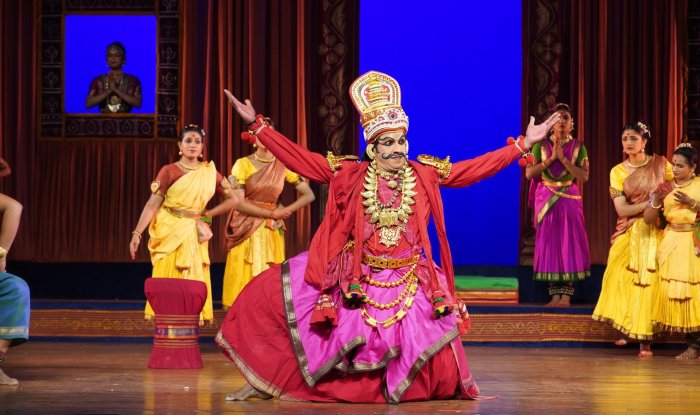 Kalakshetra group Kalakshetra Foundation's exposition of the Ramayana in the traditional dance drama format was quite refreshing for the audience. The authentic music based on varied Carnatic ragas that reveal the story line of Ramayana, the strong characterisation of Rama, Lakshmana, Sita, Hanuman and Ravana was elevating. Besides the sparkling and precise movements, the complete involvement of all the participants, made the entire experience quite enriching. Maintaining the choreography and the insight as directed by the pioneer dancer and founder of Kalakshetra, Dr Rukmini Devi Arundale, was not an easy task. Kudos to the entire team. Kathak dancer Archana Joglekar and group from USA presented a spirited Kathak performance. In a recorded music track, it's not easy to maintain the rhythmic precision, you cannot afford to be even few seconds late, otherwise you will not be able to keep pace with the rhythmic quality of the performance. With over thirteen female dancers dancing together with only one male dancer in the center, Vaibha Krishna Maharaj was a rare spectacle. The technical quality of the performance was well maintained, as the dancers thrilled the spectators with variety in rhythmic patterns. They started the performance with Ritu Rang Darshan with music by Sudhir Phadke. In the expressional exposition, three Nayikas (heroines) were depicted, namely "Roop Garvita"- the proud and snobbish one who feels that she is doing a favour to God by visiting the temple; the second one was Shakkini, who is always complaining and doubtful of the intention of others and last one was the jealous one who is disturbed as she compares herself with others. This was more suggestive and on the surface level only. Archana is the disciple and daughter of Guru Asha Joglekar and has established her dance academy in New Jersey. Lok Chhanda Cultural Unit from New Delhi presented Sarvesham Bharatah, a fine amalgamation of classical and some folk styles too with rhythmic and melodious music that enhanced the artistic fervour amidst the audience. It blended Bharatanatyam, Kuchipudi, Mohiniattam, Kathak, Manipuri, Odissi and Kathakali performed together in fine synchronisation. To watch the two Kathakali dancers dancing in fast tempo was a rare spectacle. 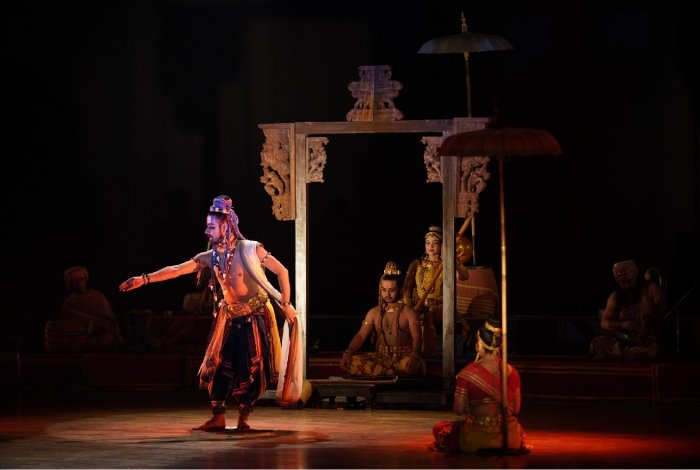 Chidakash Kalalay Uparoopak Bhaanak presented by Chidakash Kalalay Centre of Art and Divinity (Kolkata), directed by Piyal Bhattacharya, was one of the most unusual and unique presentation of the festival that attracted the standing ovation from the audience. It was particularly noteworthy for the structure of presentation and the rich content, based on the Natya Sastra and Sanskrit theatre. Bhaanak is a journey towards the unconditional ecstasy "aanand". It is a journey of melody, songs and dances to everyone, despite their countless conditioning. Sutradhar renders Udanta or teachings to the audience on the metaphysics and dynamics of Sangeet, Naad, Shareera and Bhrahmanaad. The Sapta Kapaal Geets are sung in 7 Shuddha Jaathis and takes the audience on a journey from the gross feelings to subtle realisations. The conceptualisation of the Bhaanak perceives Sutradhar as guide for this journey, seated within 3 Devis - Sauree Vaak, Kaalika and Ambhrinee Vaak. They are the cosmic embodiment of energy deeply embedded respectively in the Svar (notes), Taal (rhythm) and Pad (literature) of the songs. The renderings were in Sanskrit and Hindi, well enacted by Sayak Mitra as the Sutradhar. Dancers were Akash Mullick, Pinki Mondal, Shreetama Chowdhury and Amrita Adhikari. The musicians were Subhendu Ghosh for Mattakokila Veena, Abhijit Ray for Kachchapi Veena, Mithun Chakravarty for pakhawaj, Seuli Chakravarty for vocal and Pritam Guha for Bangla dhol. 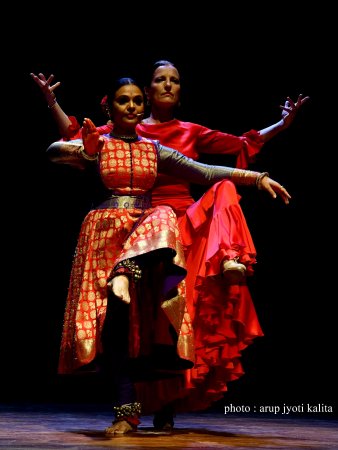 Kathak and Flamenco One of the most thrilling performances was the fine combination of Kathak with the Spanish Flamenco, performed by Aditi Bhagwat from Mumbai and Bettina from Spain. Bettina Castano appeared amidst the audience and ascended the stage while snapping her fingers with the little musical instrument held between the fingers, that creates quite a pleasant tapping sound and soon joined Aditi in the invocation number. The jugalbandi between Kathak and Flamenco maintaining fine rhythmic synchronisation was the highlight of the performance which was well applauded by the audience. Percussion was by Emmanuel Simon and tabla by Unmesh Banerjee. 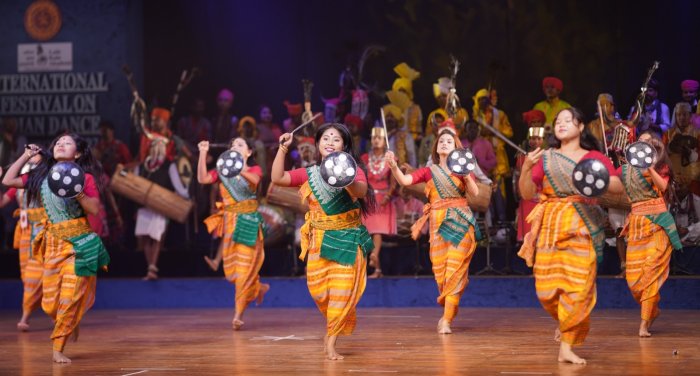 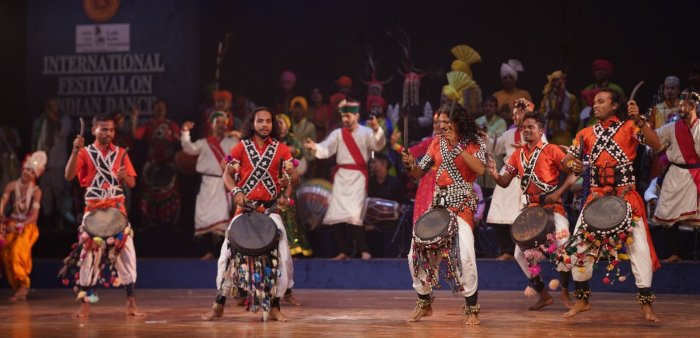 The Kamani auditorium was the venue where Folk Musical Ensemble from Uttarakhand was presented by Devbhumi Lok Kala Society (Delhi), Kachchi Ghodi dance from Rajasthan was performed by Banwarilal and group from Jaipur, Rasiya from Haryana was presented by Vedprakash and group from Palwal, Been Jogi from Haryana was presented by Pritam Singh and group (Delhi), Singari Melam from Kerala was performed by Delhi Panchavadyam Trust and Rasiya from Haryana performed by Badan Singh and group from Banchari. The varied groups welcomed guests and dignitaries with traditional dance and music. 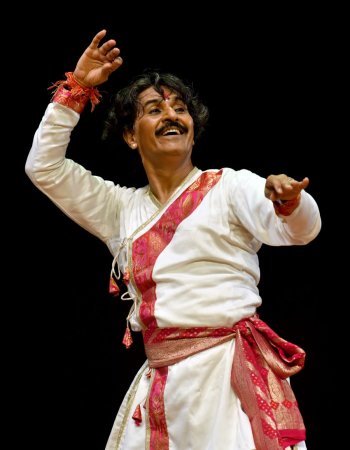 Rajendra Gangani (Photo: Arup Jyoti Kalita) 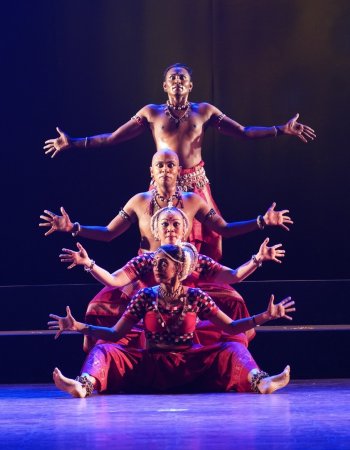 Sutra Dance Theatre 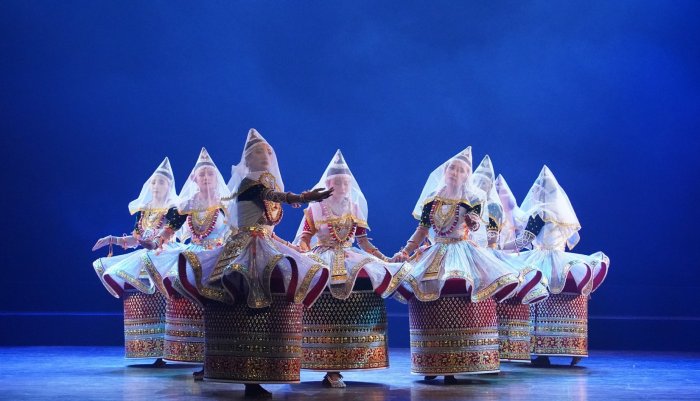 JN Manipuri Dance Academy 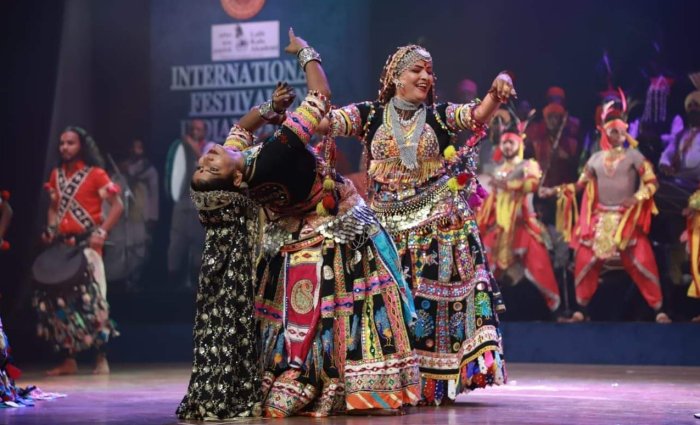 Kalbelia Besides the Maha Raas exposition by the dancers of Jawaharlal Nehru Manipuri Dance Academy from Imphal, Ramli Ibrahim from Malaysia presented Odissi by the dancers from Sutra Foundation with elegance and vibrancy with the inclusion of male dancers. It was heartening to watch both males and females dancing Odissi with equal passion and spontaneity. The last performer of the festival was the brilliant Kathak dancer Rajendra Gangani. Prior to his performance was the folk dance presentation which was so colourful and vibrant as more than 200 dancers performed simultaneously in different numbers like Bhangra, Kalbelia, Garba, Karagattam, Dhol Cholom in Manipuri dance and several others, creating a grand finale to the international festival. Kudos to Minister of Culture, Gajendra Singh Shekhawat, Chairperson Dr Sandhya Purecha, vice chairman Joravarsingh, Secretary Raju Das and the complete staff of Sangeet Natak Akademi for this great festival. 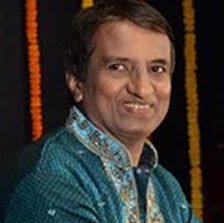 Vijay Shankar is a Kuchipudi and Kathakali exponent, teacher, bilingual journalist, arts critic and actor. |